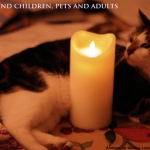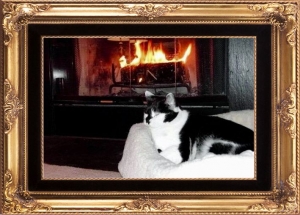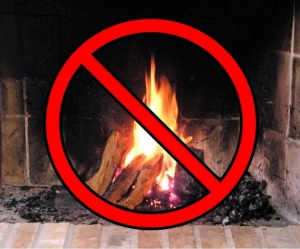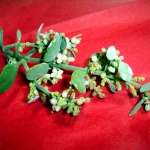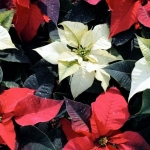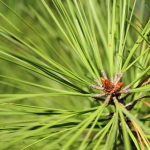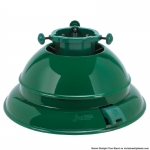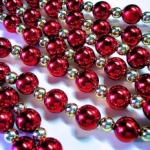Pet-Friendly Holiday Decorating
The winter holiday season is a time for joyful celebration. When pets are part of your family, pet-friendly holiday decorating is essential. Keep the holidays happy and safe with these tips.
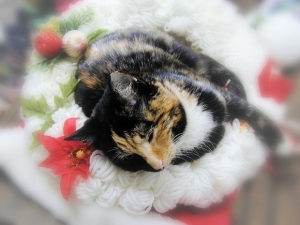
Keep the Home Fires Burning—Safely
Fire provides a warm glow in the midst of winter cold. But open-flame ambiance must be handled with extra care.
The Welcoming Flicker of Candlelight
Many holiday traditions, such as an Advent wreath or Chanukah menorah (chanukiah), include lighting candles with open flames. Curious pets may want to investigate them more closely. They should never do so without supervision. Aside from the danger of the flames themselves, dripping wax can also burn your pet.
In addition to the candles used for traditional religious observances, many of us like to illuminate our homes with the radiance of candlelight during the winter holidays. Scented candles have become ubiquitous. Fragrances such as pine, sugar cookie, cranberry, peppermint, and gingerbread can bring back memories of old-fashioned holiday celebrations.
Bear in mind, however, that these aromas are usually concocted in a laboratory. Our pets are particularly sensitive to inhaled chemicals. In high enough concentrations, even natural-sounding “essential oils” can be toxic to our pets. The chemicals used in scented candles (and other scented products, such as plug-in air fresheners, and air freshener sprays) may cause respiratory distress in dogs and cats. Moreover, scented candles are a recognized seizure trigger for epileptic pets.
Flameless candles are an increasingly popular alternative to traditional candles. As the technology improves, flameless candles more realistically simulate the flickering of candlelight—without the hazards of fire and hot wax. Flameless candles also offer features not available with traditional candles, such as timers that automatically turn the candles on and off. (You can even buy flameless candles with remote controls!) While it is possible to buy scented flameless candles, the safer choice for your pets’ health is still unscented.
The Fire is So Delightful
A big, roaring fire is often associated with holiday get-togethers. Sometimes, the heart-warming hearth brings its magic to a long winter’s night of solitude. Images of “home and hearth” have been part of our cultural lexicon for centuries. Many of these images include a cat curled up near the fireplace, savoring its warmth.
A great roaring fire is also a source of live sparks. While not strictly part of pet-friendly holiday decorating, fireplace safety is often an issue during the winter holiday season. Pets are naturally attracted to the warmth and motion of open flame.
In addition to keeping the flue open and the room well-ventilated, make sure that your pets’ curiosity does not lead to burns. The fiery beauty of the hearth must be tempered with a protective screen or fireplace door for safety’s sake.
Decking the Halls
Winter holiday decorations can be fraught with potential danger for pets. Many of these dangers involve plants traditionally associated with the holidays. Even more modern decorations, such as breakable ornaments and metallic “icicles”, could potentially harm your pets.
Poisonous Seasonal Plants
Holly, mistletoe, amaryllis, and poinsettia are all toxic to varying degrees, if ingested. In addition to possibly affecting pets’ nervous systems, sharp holly leaves can cause digestive tract damage when swallowed. While the first line of defense is eliminating your pet’s unsupervised access to these hazards, it’s important to know the signs and symptoms of poisoning: Look for vomiting or diarrhea, excessive salivating or licking, convulsions, lethargy, trouble breathing, or appetite changes. Any of these symptoms warrant immediate medical attention.
Here is a link with an exhaustive list of plants poisonous to dogs, along with symptoms of poisoning caused by each type of plant. These lists, provided by the ASPCA, include plants poisonous to either cats or dogs. The individual lists for dogs and cats also include non-toxic plants, so you can see which types of plants are safe to use as decorations. When filtered alphabetically (by plant name), the ASPCA lists include pictures of most of the plants, for identification purposes.
Christmas Tree Safety
As one of the most recognized and beloved winter holiday symbols, Christmas trees are an iconic decoration. Christmas trees can also be hazardous to your pets in several ways.
Pine and fir, two of the most popular evergreens used as Christmas trees, can be toxic for both cats and dogs. Toxicity varies according to tree species, the size of your pet, and number of needles ingested.
If you have a live tree, keep it well-watered to avoid needle-dropping. Clean up dropped needles as often as needed to keep them out of your pets’ reach. Even the oils from the needles may harm your pet: Fir oils in particular can irritate a dog’s mouth and stomach. Regardless of the toxicity of the tree variety itself, swallowing sharp needles (such as those from a pine tree) can seriously damage a pet’s digestive tract. Swallowed needles can also cause an intestinal obstruction. Surgery may be necessary to remove the blockage.
Fido may lap up the water from the base of a live tree. Fluffy might also take a drink from the tree water. Try a closed tree stand, which prevents our furry companions from using the tree stand as a water bowl. Especially when the tree is initially watered at home, the flame retardants and preservatives used to treat the tree may leach into the tree water. Drinking it could mean sickness or organ failure for your pet.
Be especially careful about chemical additives, such as those used to extend the life of the tree: Aspirin, sugar, vodka, fertilizer, bleach, and even hairspray are common household items added to tree water to preserve the tree. There are also commercial products made for this purpose. Many of these choices pose a serious danger to your pets’ lives. Ironically, plain water has been shown to make your tree last longer than any water additives. Try these tips to keep your tree fresher longer without endangering your pets.
Make sure all electrical wires attached to twinkle lights and decorations are safely tucked away. Avoid using any decorations with frayed wires. This is especially important if you have a pet who likes to chew on inedible objects. The novelty of the decorations may draw them in, and their curiosity may lead them to explore the exciting new objects with their mouths. Electrical burns may be the unfortunate result of their inquisitiveness.
Metallic tinsel icicles are an old-fashioned favorite. They hang from the branches of the Christmas tree, their sparkle imitating the glint of moonlight on ice. They are also a serious safety hazard for cats, who may be inclined to swallow the shiny, dangling strings during play. This can lead to intestinal blockage, or even severing of the cat’s intestines (due to muscle contractions). If you suspect your cat has swallowed any string-like object, never attempt to remove it yourself—even if you can see one of the ends emerging from one of your cat’s orifices. Your actions, while well-intentioned, may cause further damage to the cat’s gastrointestinal system. Take the cat immediately to the veterinarian for professional care.
Tinsel garland will eventually shed. Although it may not be long enough to do the same kind of immediate damage as tinsel icicles, it could cause an intestinal obstruction if enough is swallowed. I have found beaded garland to be a safer alternative to tinsel garland. It still adds color and shine to your tree, while posing less threat to your pets than tinsel.
Keep glass Christmas balls and other fragile ornaments away from the base of the tree. This will make them less easily accessible to your pets. Even if the intact ornaments pose no immediate danger, broken ornaments—shards of glass or ceramic— will likely lead to external cuts. If swallowed, they could cause internal lacerations.
None of us, most especially our pets, want to spend the holidays at the emergency vet clinic. When in doubt about the safety of any decoration, err on the side of caution.
Celebrating Safety during the Winter Holidays
We all look forward to good times with friends and family during the coming holiday season. By keeping our furry family members safe, we can better enjoy our winter holidays. And happy, healthy pets are always something to celebrate!


